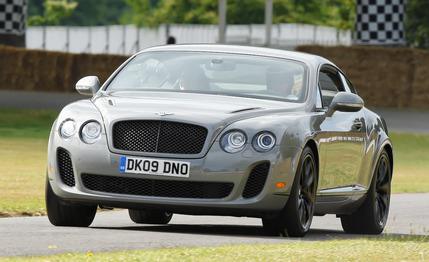 First Drive Review
First Drive Review
Bentley describes the new Continental Supersports as “a fusion of extremes.” And that it is, starting with the name itself, which fuses the “Continental” badge, which dates to the brand’s 1950s models, and “Supersports,” a descriptor first given to a series of speed-record-setting Bentleys in the 1920s. The styling is a blend of the elegant body shape of the Continental GT coupe and sinister elements such as black wheels and gaping front intakes. The interior remains inarguably luxurious yet eschews stodgy wood and puffy seats in favor of intense carbon-fiber trim and lightweight racing shells.
If this sounds like high-brow automotive schizophrenia, know that each enhancement achieves the purpose stated by the Supersports name, contributing small but effective measures that elevate the Supersports out of the sphere where normal Continentals exist and into a world of faster, more exclusive, and even more prestigious nameplates. Think of it as a big-boned Aston Martin DBS, and you won’t be far off.
Bespoke, Be-Bad-Ass Styling
“We took the look of the [Continental] GT and tweaked it a little to give it a little more menace,” said Bentley board-member-in-chief Stuart McCullough during the press introduction of the Supersports in upstate New York. Specific changes include a front end dominated by a constellation of large black air apertures and four dark-trimmed headlamps. A set of gloss-black 20-inch wheels fill the wells, the rearmost framed by a subtle fairing to accommodate a full two-inch increase in rear track. Gloss black also finishes the lower-body spear trim and window surrounds, and the rear spoiler features an extra lip contour for aero purposes. Finishing the intensified package are smoked taillamps and a unique lower-bumper cap bracketing twin ovoid exhaust finishers. Two new colors—Ice (white) and Quartzite (gray)—are offered on the Supersports, as are two new matte finishes in dark and light gray.
A Kiss on the Cheek? Not this Continental
No matter the color, the styling of the Supersports will never be described as subtle. However, there remains a savory element of surprise that qualifies the Supersports as the ultimate street-fightin’ Bentley, especially in areas such as Los Angeles and Miami, which are veritably overrun with Continentals more benign, including the impressive Speed versions that now account for a majority of Continental sales. Even the most hopped-up Continentals will have a hard time keeping up with the Supersports, given how comprehensively this car has been enhanced under its skin.
That said, none of the Supersports’ enhancements is a big game changer by itself. According to lead engineer Brian Gush, the Supersports wasn’t originally part of the product plan but rather the result of the engine team coming up with an extra 21 horsepower and 37 lb-ft of torque from the twin-turbocharged W-12 (future Supersports will use an E85-capable version of the engine, a first for a Bentley). Drivetrain engineers simultaneously developed Quickshift programming for the six-speed automatic and a 40/60-percent front-to-rear torque split for the all-wheel-drive system. Gush explained that once they realized the car’s potential as a “whole different animal” from even the Continental GT Speed, they installed huge carbon-ceramic brake discs (with eight-piston front calipers), which reduced weight by 11 pounds at each wheel. More weight loss came about by yanking the rear seats and swapping out wood trim for satin-finished carbon fiber (together saving an additional 57 pounds) and switching the heavy front buckets to carbon-backed racing seats (losing another 100 pounds). Twenty or so more pounds were saved elsewhere on the chassis, including unsprung areas, resulting in an overall weight reduction of nearly 250 pounds. The body people did their part to make the Continental meaner-looking and to facilitate better engine breathing, and thus the Supersports was born.
Where does that leave the steel-bodied car’s curb weight? At a “mere” 4939 pounds, which is still spectacularly porky, especially for a two-seater. Still, with 590 lb-ft of torque at one’s disposal from 1700 rpm until nearly redline, the Supersports could be a full ton heavier and still outrun many cars half its weight. As it is, however, this Bentley is no slug, said to be able to hit 60 mph in 3.7 seconds, with 100 mph coming up in 8.9. Terminal velocity is said to be a lofty 204 mph. Passing power is mind-blowing, according to Bentley: 30 to 50 mph happens in 1.6 seconds, which is actually less time than it takes to say “1.6 seconds,” and the 50-to-77-mph pass takes 2.1 seconds. This is the sort of power that curls your neck muscles around your upper vertebrae and shoves your tongue down your throat. Lattes will spill, cell phones will fly, and whimpering Chihuahuas will be flattened against the quilted bulkhead that replaces the rear seats.